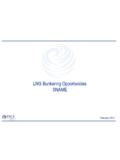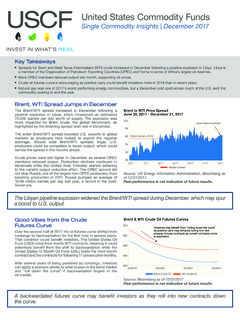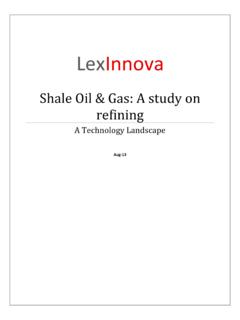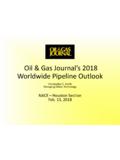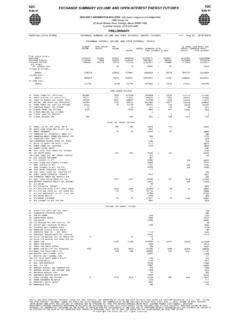Transcription of A GUIDE TO ENERGY HEDGING - Commodity, Futures and …
1 A GUIDE TO ENERGY HEDGING . 1. Other Considerations ..38. Basis ..38. Example 12 Effect of Basis on a Fuel Dealer's Hedge ..41. Exchange of Futures for Physicals ..42. Mechanics of an EFP ..43. Example 13 Use of an EFP to Initiate a Position ..44. Example 14 Use of an EFP to Liquidate a Position ..44. Blind vs. Selective Hedge ..46. Technical Analysis ..46. Charting Price Trend Lines ..47. Volume and Open Interest ..48. Options ..50. Determinants of an Options Premium ..51. Strike Price vs. Futures Price ..51. Time Value ..52. Call/Put Parity ..52. Volatility ..53. Interest Rates ..54. Example 15 Setting a Cap on Gasoline Prices by Buying Calls ..54. Example 16 Setting a Floor Against a Gasoline Price Decline by Buying Puts ..55. Example 17 Purchasing an Out-of-the-Money Call to Cap natural Gas Prices in a Potential High-Volatility Market.
2 56. Example 18 HEDGING Against a natural Gas Price Decline in a Potential High-Volatility Market with Out-of-the-Money Puts ..57. Collars ..58. Example 19 An Industrial Gas Consumer Uses a Collar to Hedge Gas Prices at an Affordable Cost ..58. Example 20 Setting a Floor With Crack Spread Options ..59. Example 21 Writing a Call Option ..60. Example 22 Creating a Fence With Crack Spread Options ..61. Conclusion ..62. Exchange Information ..63. 2 1. INTRODUCTION TO THE NEW YORK. MERCANTILE EXCHANGE. Significant, sometimes abrupt, changes in supply, demand, and pricing have touched many of the world's commodity markets during the past 25 years, especially those for ENERGY . International politics, war, changing economic patterns, and structural changes within the ENERGY industry have created considerable uncertainty as to the future direction of market conditions.
3 Uncertainty, in turn, leads to market volatility, and the need for an effective means to hedge the risk of adverse price exposure. The principal risk management instruments available to participants in the ENERGY mar- kets today are the versatile Futures and options contracts listed on the New York Mercantile Exchange. The contracts are designed to meet the needs of the modern ENERGY industry by encompassing the standards and practices of a broad cross-section of the trade. The Exchange is the world's largest physical commodity Futures exchange. Trading is conducted through two divisions: the NYMEX Division offers Futures and options contracts for light, sweet crude oil; heating oil; New York Harbor gasoline; natural gas; electricity; and platinum; Futures for propane, palladium, sour crude oil, Gulf Coast unleaded gasoline; and and options contracts on the price differentials between heating oil and crude oil, and New York Harbor gasoline and crude oil, which are known as crack spread options.
4 The COMEX Division lists Futures and options on gold, silver, copper, aluminum, and the FTSE Eurotop 100 European stock index; and Futures for the FTSE Eurotop 300 . stock index. The NYMEX Division heating oil Futures contract, the world's first successful ENERGY Futures contact, was introduced in 1978. The light, sweet crude oil contact, launched in 1983, is the most actively traded Futures contract based on a physical commodity in the world. These contracts, and the others that make up the Exchange's ENERGY complex have been adopted as pricing benchmarks in ENERGY markets worldwide. NYMEX ACCESS . The Exchange's electronic trading system, NYMEX ACCESS , allows trading in ENERGY Futures and options, platinum Futures and options, and other metals Futures after the trading floor has closed for the day.
5 The NYMEX ACCESS trading session for light, sweet crude oil; heating oil; New York Harbor unleaded gasoline; and the metals contracts begins at 4 and concludes at 8 the following morning, Mondays through Thursdays. A. Sunday evening session commences at 7 When combined with the daily open outcry session, NYMEX ACCESS extends the trading day to approximately 22 hours. 3 3. natural gas and propane are offered in abbreviated evening sessions. Electricity con- tracts trade exclusively on NYMEX ACCESS for approximately 23 hours a day. Terminals are in use in major cities in the United States and in London, Sydney, Hong Kong, and Singapore. Efficient Markets Require Diverse Participants To be efficient and effective risk management instruments, Futures markets require a mix of commercial hedgers and private speculators.
6 The New York Mercantile Exchange's ENERGY markets have attracted private and institutional investors who seek to profit by assuming the risks that the underlying industries seek to avoid, in exchange for the possibil- ity of rewards. These investors, in combination with hedgers, have brought a diversified balance of participants to the Exchange's markets. How a Transaction Works The execution of a transaction on the trading floor is a finely honed process that can be completed in seconds. The open outcry auction process on the floor assures that transac- tions are completed at the best bid or offer. The process starts when a customer calls a licensed commodities broker with an order to buy or sell Futures or options contracts. The broker sends the order to his firm's repre- sentative on the trading floor via telephone or computer link.
7 An order slip is immediately prepared, time stamped, and given to a floor broker who is an exchange member standing in the appropriate trading ring. All buy and sell transactions are executed by open outcry between floor brokers in the same trading ring. Buyers compete with each other by bidding prices up. Sellers compete with each other by offering prices down. The difference between the two is known as the bid-ask spread. The trade is executed when the highest bid and lowest offer meet. When this trade is executed, each broker must record each transaction on a card about the size of an index card which shows the commodity, quantity, delivery month, price, broker's badge name, and that of the buyer. The seller must toss the card into the center of the trading ring within one minute of the completion of a transaction.
8 If the last line on the card is a buy, . 4 3. the buyer also submits the card to the center of the ring; the card is retained by the Exchange as part of the audit trail process. The cards are time-stamped and rushed to the data entry room where operators key the data into the Exchange central computer. Meanwhile, ring reporters listen to the brokers for changes in prices and enter the changes via hand-held computers, immediately disseminating prices to the commercial price report- ing services as they simultaneously appear on the trading floor wallboards. Confirmation of each completed trade is immediately made by the floor broker's clerk to the originating broker who then notifies his customer. 5 5. Futures . What are Futures ? Futures contracts are firm commitments to make or accept delivery of a specified quantity and quality of a commodity during a specific month in the future at a price agreed upon at the time the commitment is made.
9 The buyer, known as the long, agrees to take delivery of the underlying commodity. The seller, known as the short, agrees to make deliv- ery. Only a small number of contracts traded each year result in delivery of the underlying commodity. Instead, traders generally offset (a buyer will liquidate by selling the contract, the seller will liquidate by buying back the contract) their Futures positions before their con- tracts mature. The difference between the initial purchase or sale price and the price of the offsetting transaction represents the realized profit or loss. Futures contracts trade in standardized units in a highly visible, extremely competitive, continuous open auction. In this way, Futures lend themselves to widely diverse participation and efficient price discovery, giving an accurate picture of the market.
10 To do this effectively, the underlying market must meet three broad criteria: The prices of the underlying commodities must be volatile, there must be a diverse, large number of buyers and sellers, and the underlying physical products must be fungible, that is, products are interchangeable for purposes of shipment or storage. All market participants must work with a common denominator. Each understands that Futures prices are quoted for products with precise specifications delivered to a specified point during a specified period of time. Actually, deliveries of most Futures contracts represent only a minuscule share of the trading volume; less than 1% in the case of ENERGY . Precisely because the Exchange's physical commodity contracts allow actual delivery, they ensure that any market participant who desires will be able to transfer physical supply, and that the Futures prices will be truly representative of cash market values.





